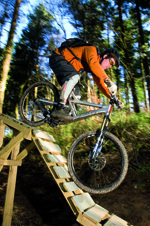 FRAME
FRAME
The aluminium Ransom frame mirrors its lighter carbon counterpart and shares the same shock, rocker link, pivot hardware, aluminium chainstays and IDS interchangeable dropouts. Both frames also have identical geometry. While the static geometry of the Ransom can’t be altered, the two additional shock settings, traction mode and lockout allow you to change the characteristics of the suspension and geometry of the bike on the trail. The lockout is excellent for fire road or tarmac climbs, and we found ourselves using the traction mode — which limits the travel to 90mm by reducing the volume of the air chamber — on everything from groomed flowing singletrack to low-speed North Shore-style trails where you actually need to pedal your bike, not wallow in 165mm of travel. Even with the extra cable going to the shock, routing on the Ransom is discreet, but you need to be careful where you position the lever on the handlebar, as we accidentally knocked it into the locked position on several occasions.
SUSPENSION
Fox’s 36Van R fork needs no introduction, but Scott’s Equalizer rear shock is something of an unknown. It’s an air-sprung shock with independently adjustable positive and negative chambers. For an 80kg rider the recommended shock pressure (conveniently printed on the swing-arm) is 367psi, which is very high and the reason why every Ransom bike or frame comes with its own high-pressure shock pump. Scott has stuck with the ‘red for rebound’ rule, but the big red dial riding on the back of the shock also doubles as a pedal platform. So if you want more efficient pedalling without reducing the travel by switching to traction mode, you simply pull the Power Stabilizer knob up. All in, the shock offers stacks of options and adjustment and, while it sounds complicated, it’s just a case of familiarising yourself with the settings. Just never leave home without your Scott shock pump.
WHEELS
The folding Stroke2 tyres on the Scott are only slightly heavier than the steel bead ?High Rollers but have considerably thicker sidewalls for additional pinch flat protection. They were the fastest rolling tyres on test but don’t offer as much grip as the others. They’re fine for dry, loamy conditions but the Stroke2s are hard work on wet roots and rocks.
PERFORMANCE
The Ransom 30 covers flat ground and ascents with considerably less effort than the Specialized or the Commençal. The saddle height is easily adjusted to suit any type of riding and the traction mode allows you to rocket up technical climbs. However, when you drop the saddle and point the Ransom downhill, the back end is no match for the Fox 36 forks. Even in full-travel mode with the Power Stabilizer switched off, the rear end just doesn’t have that planted feeling that the Commençal and Specialized both deliver. Braking bumps that the other bikes dismiss have the Scott bounding around like a short-travel XC trail bike. Stiction in the rear shock was noticeable on the first outing and just got worse, and is the most likely causes of the inadequate rear suspension. Stiction also makes it more difficult to predict the Ransom 30’s behaviour, as you never know where you are in the travel. When it does kick in you have to use more body English to counterbalance the rearward weight shift.
VERDICT
Scott’s traction mode should be available on all long-travel applications that have to be ridden up as well as down — and combined with the impressive range of saddle height adjustment, make the Ransom 30 a truly versatile bike. Our only complaint is that the rear suspension isn’t plush enough for the Ransom 30’s freeride guise. With better shock performance the Ransom 30 could be that elusive do-it-all, big-mountain bike. But, as it stands, it is coming up just a little short.
MBR RATING: 7/10



